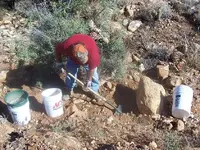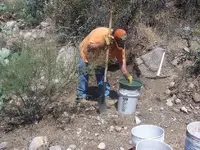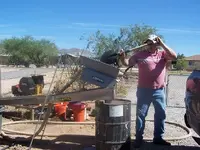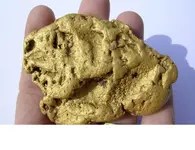Klondikeike
Full Member
OKAY!! You've found some gold...Now what!
Klondike here...
As most of you know.. I am a professional miner.... and usually only mine on properties that have commercial quantity values...
Some of you older and seasoned prospectors, probably do something similar.. I am really talking to the ones who are new to prospecting.. or just don't know what to do next once they have panned a few flakes...
********************************************************************************
How do you know if to stay and keep coming back... or give up.... while you are out there and find a few flakes of gold...?
Is, a few flashy specs of gold in the pan, while certainly encouraging... the reason you stay and keep digging....for most of us YES !
I want to share with you fellow prospectors... something I recommend everyone to do once you have found some gold in your pan..before yo decide to really set up camp.....or buy... or stake a claim..
If prospecting is just a recreational adventure for and you want the exercise and don't care about how much gold you'll ever recover.... ignore what I am about to tell you...
But if you are out for some recreational exercise and you want to take your "find" to the next level... then read closely and adopt these simple "rules" and actions...and it take discipline to do this each time before just "jumping in"...as it were...
Ask yourself these questions and answer them honestly...
** How material does your gold pan hold..?.... most will guess or just don't know....
** How much does each shovel full of dirt you place into the hopper of a high banker or sluice ...have in it..?.. most will guess
You see, most of us do the same thing..especially in the early days of your prospecting ventures....we pan or sluice and see some gold and say....and get excited..."wow this is a great spot..." without ever knowing how much material you ran for sure...to get those few flakes of gold... so we resort to ..."well we shoveled for 3 hours..then cleaned up.. Pretty good isn't it..? Am I right? YES!!!
So make your mind up to do the following... yes it is mediocrity.. and boring.. but in the end... you'll know just where you stand and if the "great property" is really all that great...
First you have to measure...(2) then run the material..and clean up and then (3) dry and weight the gold recovered and (4) finally calculate how much valuable yield you have per yard...
This is important...!
There about 40 full, screened and reasonably packed 5 gal buckets to 1 yard of material....
Instead of just setting up here and start shoveling... use buckets as described above and you can keep track of the REAL amount of material you have moved...and once .. you do this, you'll be surprised of the ALL those yards you shoveled last year... really weren't close to being that many yards at all...
I usually usually take 10 to 12 buckets with me... but only use 4 to 8....
It is hard to carry a full, screen and compacted bucket of dirt any lengthy distance...and in some cases you may have to...
If I fill up, 8 buckets..and since I have more buckets than I need for this sample.... I can now separate the material into the empty buckets and each bucket will be lighter to carry..but we still have the same 1/5 of a yard material...
Remember to initially screen the material as you place it into the buckets...say to about 1/4 in or 1/2 in or so....
With 8 buckets, I have about 1/5 of a yard of clean material to process across my dry washer.. or sluice or high banker...or whatever....
Now... run that material.... clean up and weigh it...and calculate.....
Lets say, for example.... from or 8 buckets.. you get 1 gram of gold....there are 31.1 grams in 1 troy ounce of gold.....
You'd have to run 248 buckets to recover 1 ounce of gold...
Lets say...you only got 1/10 of a gram...from those 8 buckets... very poor material indeed......but probably more realistic... you'd have to run 496 buckets to get an ounce...
And you know for sure if a property is worth buying or staking... you should do many of this sampling process before you buy or stake...
And folks... on public lands, you don't need a permit to do this.. it is considered "Casual Use"...
Below are some pics. I took of a recent outing looking to buy a property...I did not find the nugget... I was seeking the fine ..small gold... I already know gold like this comes off this property...this nugget was found by someone else... on a neighboring property...
Hope this helps...
Happy and prosperous mining to all...
Klondike...
Klondike here...
As most of you know.. I am a professional miner.... and usually only mine on properties that have commercial quantity values...
Some of you older and seasoned prospectors, probably do something similar.. I am really talking to the ones who are new to prospecting.. or just don't know what to do next once they have panned a few flakes...
********************************************************************************
How do you know if to stay and keep coming back... or give up.... while you are out there and find a few flakes of gold...?
Is, a few flashy specs of gold in the pan, while certainly encouraging... the reason you stay and keep digging....for most of us YES !
I want to share with you fellow prospectors... something I recommend everyone to do once you have found some gold in your pan..before yo decide to really set up camp.....or buy... or stake a claim..
If prospecting is just a recreational adventure for and you want the exercise and don't care about how much gold you'll ever recover.... ignore what I am about to tell you...
But if you are out for some recreational exercise and you want to take your "find" to the next level... then read closely and adopt these simple "rules" and actions...and it take discipline to do this each time before just "jumping in"...as it were...
Ask yourself these questions and answer them honestly...
** How material does your gold pan hold..?.... most will guess or just don't know....
** How much does each shovel full of dirt you place into the hopper of a high banker or sluice ...have in it..?.. most will guess
You see, most of us do the same thing..especially in the early days of your prospecting ventures....we pan or sluice and see some gold and say....and get excited..."wow this is a great spot..." without ever knowing how much material you ran for sure...to get those few flakes of gold... so we resort to ..."well we shoveled for 3 hours..then cleaned up.. Pretty good isn't it..? Am I right? YES!!!
So make your mind up to do the following... yes it is mediocrity.. and boring.. but in the end... you'll know just where you stand and if the "great property" is really all that great...
First you have to measure...(2) then run the material..and clean up and then (3) dry and weight the gold recovered and (4) finally calculate how much valuable yield you have per yard...
This is important...!
There about 40 full, screened and reasonably packed 5 gal buckets to 1 yard of material....
Instead of just setting up here and start shoveling... use buckets as described above and you can keep track of the REAL amount of material you have moved...and once .. you do this, you'll be surprised of the ALL those yards you shoveled last year... really weren't close to being that many yards at all...
I usually usually take 10 to 12 buckets with me... but only use 4 to 8....
It is hard to carry a full, screen and compacted bucket of dirt any lengthy distance...and in some cases you may have to...
If I fill up, 8 buckets..and since I have more buckets than I need for this sample.... I can now separate the material into the empty buckets and each bucket will be lighter to carry..but we still have the same 1/5 of a yard material...
Remember to initially screen the material as you place it into the buckets...say to about 1/4 in or 1/2 in or so....
With 8 buckets, I have about 1/5 of a yard of clean material to process across my dry washer.. or sluice or high banker...or whatever....
Now... run that material.... clean up and weigh it...and calculate.....
Lets say, for example.... from or 8 buckets.. you get 1 gram of gold....there are 31.1 grams in 1 troy ounce of gold.....
You'd have to run 248 buckets to recover 1 ounce of gold...
Lets say...you only got 1/10 of a gram...from those 8 buckets... very poor material indeed......but probably more realistic... you'd have to run 496 buckets to get an ounce...
And you know for sure if a property is worth buying or staking... you should do many of this sampling process before you buy or stake...
And folks... on public lands, you don't need a permit to do this.. it is considered "Casual Use"...
Below are some pics. I took of a recent outing looking to buy a property...I did not find the nugget... I was seeking the fine ..small gold... I already know gold like this comes off this property...this nugget was found by someone else... on a neighboring property...
Hope this helps...
Happy and prosperous mining to all...
Klondike...
Amazon Forum Fav 👍
Attachments
-
 doesn\'t look like much.. but very rich indeed....webp57.9 KB · Views: 725
doesn\'t look like much.. but very rich indeed....webp57.9 KB · Views: 725 -
 digging material for screening.webp136.2 KB · Views: 729
digging material for screening.webp136.2 KB · Views: 729 -
 screening material to bucket.webp100.4 KB · Views: 740
screening material to bucket.webp100.4 KB · Views: 740 -
 another sample location..8 more buckets....webp132.8 KB · Views: 737
another sample location..8 more buckets....webp132.8 KB · Views: 737 -
 processing the 8 buckets....webp68.5 KB · Views: 742
processing the 8 buckets....webp68.5 KB · Views: 742 -
 Gold Nugget.webp113.3 KB · Views: 806
Gold Nugget.webp113.3 KB · Views: 806
Upvote
0




